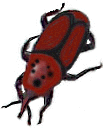...Best of Sicily presents... Best of Sicily Magazine. ... Dedicated to Sicilian art, culture, history, people, places and all things Sicilian. |
by Vincenzo Mormino | ||
Magazine Index Best of Sicily Arts & Culture Fashion Food & Wine History & Society About Us Travel Faqs Contact Map of Sicily |
The challenge posed by such "invading species" is that once they move beyond their native habitats they leave behind the natural predators which keep their populations down back home. In a new environment they can literally eat whatever they please until they have destroyed their new food source and, in the case of date and coconut palms, an edible human food as well. One unwelcome species that comes to mind, referred to in the press as "Fishzilla," is the toothy, hungry south-east Asian snakehead fish (channa argus) that in American waters consumes all kinds of edible fish, altering the native populations of entire lakes and rivers and occasionally biting swimmers. How extensive will the beetle damage be? For the moment, there seems to be no effective pesticide available to combat these pests. Certain palm tree varieties, though a small minority of those cultivated in Sicily, are immune to the weevils. Prominent among these is the American palm of the genus Washingtonia popular in Mexico and California (washingtonia filifera and washingtonia robusta). Introduced into Sicily about a century ago, it has a very high, slender trunk and fan-like branches clumped around a nucleus. It grows much taller and faster than the traditional date palm and has a completely different profile, but this may be the price to pay for the loss of the thick-trunked date palms. As a safety measure, roadside trees are being cut down to forestall possible collapses onto cars or people due to trunk damage from the bugs. Though date palms were grown in southern Italy for brief periods during the ancient Roman era, their most extensive cultivation, on large plantations, took place in Sicily during the Arab period. By around 1300 they were considered an ornamental tree, so the fruit was not harvested and dates are found in very few traditional Sicilian recipes. Despite the presence of dates falling to the ground beneath the trees in public gardens, most Sicilians are unaware that the trees so evident here are, in fact, date palms. Most of the dates sold in Sicily are imported from northern Africa, especially Tunisia. That may change as Tunisia's date palms are destroyed by the hungry weevils. It isn't altogether inappropriate to ascribe human virtues and vices to certain insects. The mantis, cricket and ladybug are all considred virtuous. The red palm weevil is just plain evil! About the Author: Vincenzo Mormino has written about wildlife and nature for Best of Sicily and hard-copy publications. | |
Top of Page |
 Can a bug change a landscape? It can if it destroys a plant species. The red palm weevil
(the photo shown here was taken in Palermo
by a member of our staff) is an Asian beetle which arrived in Sicily via
Egypt two years ago - probably in a shipment of infected plants - and is
devouring the island's date palms by boring large networks of tiny tunnels
into the trunks. Rhynchophorus ferrugineus, which Italians call the
punteruolo rosso, had already caused the destruction of over thirteen
thousand date palms in Sicily by August 2009, and there's no end to the
massacre in sight. The bug has invaded mainland Italy, killing trees as
far north as Genoa, and has recently landed in Spain. The global impact
of its migration is serious; it has even been discovered in the Caribbean.
Can a bug change a landscape? It can if it destroys a plant species. The red palm weevil
(the photo shown here was taken in Palermo
by a member of our staff) is an Asian beetle which arrived in Sicily via
Egypt two years ago - probably in a shipment of infected plants - and is
devouring the island's date palms by boring large networks of tiny tunnels
into the trunks. Rhynchophorus ferrugineus, which Italians call the
punteruolo rosso, had already caused the destruction of over thirteen
thousand date palms in Sicily by August 2009, and there's no end to the
massacre in sight. The bug has invaded mainland Italy, killing trees as
far north as Genoa, and has recently landed in Spain. The global impact
of its migration is serious; it has even been discovered in the Caribbean.